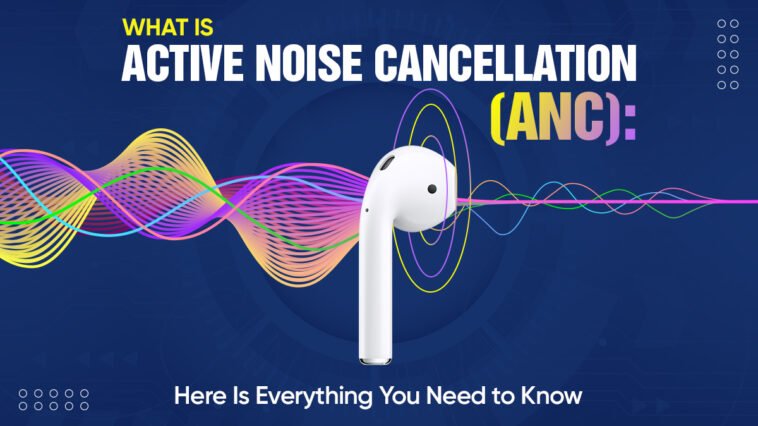Have you ever been on a flight or in a noisy café, trying to enjoy your favorite tunes or focus on a podcast, but all you can hear is the constant hum of engines or the chatter around you? Enter Active Noise Cancellation (ANC) – the tech magic that transforms your noisy environment into a serene soundscape.
Whether you’re a frequent traveler, a student, or someone who loves peace and quiet, ANC is here to save your eardrums and sanity. How it works however is a mystery to many people, devolving into a bunch of technobabble for most consumers. So, to alleviate that, let’s dive into what ANC is all about and why it’s become such a game-changer in audio technology.
How Does ANC Work?

So, how does Active Noise Cancellation work? It might seem like sorcery, but it’s all about some clever audio engineering. Here’s the lowdown:
- Microphones: Your ANC headphones or earbuds are equipped with microphones that pick up ambient noise from your surroundings. Typically, these are tiny, high-sensitivity microphones strategically placed on the exterior or interior of the headphones. Their job is to capture the incoming sound waves accurately.
- Processing: Once the microphones pick up the ambient sounds, the device’s internal circuitry kicks into gear. This circuitry includes a digital signal processor (DSP) that analyzes the sound waves. The DSP measures the frequency and amplitude of the incoming noise, essentially creating a sonic map of your environment.
- Anti-Noise Waves: The magic happens when the device generates sound waves that are the exact opposite (or “phase-inverted”) of the ambient noise. These anti-noise waves are produced by tiny speakers inside the headphones. When the anti-noise waves meet the ambient noise waves, they cancel each other out through a process called destructive interference.
- Result: The result? A blissfully quiet listening experience, letting you focus on what you want to hear, not the background buzz. This process happens continuously and in real time, ensuring that you’re always shielded from unwanted sounds.
This technology is not limited to headphones. ANC is also used in other applications like cars, where it helps to reduce road noise, and even in office environments, where it can create quieter workspaces. It simply works extra well in audio consumer products like your headphones!
What Are Different Types of ANC
ANC technology isn’t one-size-fits-all. There are different types, each suited for various environments and uses:
- Feedforward ANC: This type has external microphones that pick up ambient noise before it reaches your ears. It’s great for reducing higher-frequency noise, such as conversations or street sounds, but can be less effective with lower frequencies like the rumble of an airplane engine. Feedforward systems are relatively simple to implement and often found in consumer-grade headphones.
- Feedback ANC: Here, the microphones are placed inside the ear cup or earbud. They detect what you’re actually hearing, and adjust the noise-canceling effect accordingly. This type excels at canceling lower-frequency sounds. Because feedback ANC reacts to what you’re hearing inside the headphones, it can adapt to changes in the noise environment more effectively. However, it’s more complex and can be prone to distortion if not properly calibrated.
- Hybrid ANC: The best of both worlds! Hybrid ANC uses both external and internal microphones to tackle a wider range of noise frequencies, offering superior noise cancellation overall. By combining the strengths of feedforward and feedback systems, hybrid ANC provides a more balanced and comprehensive noise cancellation experience. This type is commonly found in higher-end headphones and earbuds, delivering the best performance in diverse environments.
What Types of Noise Cancellation are there?
When it comes to blocking out noise, it’s not just about ANC. There are other noise-cancellation methods to be aware of:
`1. Passive Noise Cancellation: This is all about the physical design of the headphones or earbuds. Think thick ear cups or snug-fitting ear tips that block out sound naturally. It’s like putting your fingers in your ears – effective to an extent, but not high-tech. Passive noise cancellation is achieved through materials and design that create a seal around or inside your ears, preventing external sound from entering. High-density foam, silicone tips, and over-ear designs are common examples.
While it doesn’t require any electronic components, passive noise cancellation can only reduce certain frequencies and isn’t adjustable.
2. Adaptive Noise Cancellation: This is a step up from regular ANC. Adaptive ANC dynamically adjusts the noise cancellation level based on your environment. Walking from a quiet library into a bustling street? Adaptive ANC will tweak itself to keep your listening experience consistent.
It uses advanced algorithms to monitor the surrounding noise and adjust the anti-noise waves in real time. This type of ANC is particularly useful for users who move through various noisy environments throughout the day, as it ensures optimal performance without manual adjustments.
3. Transparency Mode: Sometimes, you actually want to hear your surroundings – like when you’re walking in traffic or having a quick chat. Transparency mode lets some external sounds in, giving you the best of both worlds: awareness and immersion. This mode uses the same microphones that capture ambient noise for ANC, but instead of canceling the noise, it amplifies and transmits it through the headphones. This way, you can stay aware of important sounds like announcements, conversations, or car horns while still enjoying your music or podcast.
What is the Difference Between ANC and ENC
Now, you might have heard about ENC – Environmental Noise Cancellation – and wondered how it differs from ANC. Here’s the scoop:
- ANC (Active Noise Cancellation): This tech is focused on improving your listening experience by reducing unwanted ambient sounds. It’s all about creating a quiet bubble around you. ANC works by using microphones to detect external noises and generating anti-noise waves to cancel them out. It’s primarily designed for personal listening, ensuring that you can enjoy your audio content without being disturbed by the noise around you.
- ENC (Environmental Noise Cancellation): ENC is designed to improve call quality by minimizing background noise on your end of the call. It uses multiple microphones to pick up your voice and filter out noise, ensuring that the person you’re talking to hears your voice clearly, even if you’re in a noisy environment. ENC is particularly useful for business calls, video conferences, and any situation where clear communication is crucial. Unlike ANC, ENC is not focused on enhancing your listening experience but rather on ensuring that your voice is transmitted clearly to others.
In a nutshell, ANC is your personal peacekeeper, making sure you hear only what you want, while ENC ensures you sound clear as a bell to others. They serve different purposes but can often be found together in high-quality headphones and earbuds, providing a comprehensive solution for both listening and communication needs.
Conclusion
Active Noise Cancellation is more than just a luxury, it’s a necessity in our bustling, noisy world. Whether you’re trying to focus, relax, or simply enjoy your music, ANC technology provides the escape you need. With different types of ANC available, from feedforward to hybrid, and additional features like adaptive noise cancellation and transparency mode, you can find the perfect fit for your lifestyle. And while ANC takes care of your listening, ENC ensures that your voice is heard loud and clear, no matter where you are. Now that you’re armed with all the info on how it works, the types available, and how it compares to other noise-cancellation methods, you can make an informed choice on your next pair of headphones or earbuds. Happy listening!
FAQ
When it comes to blocking out unwanted noise, the battle between Active Noise Cancellation and Passive Noise Cancellation is one for the ages. Generally, we would say that ANC is the better solution. ANC features superior noise reduction, adapting to your environments and offering different modes.
The downside however is that it saps battery faster, and ANC-powered audio products tend to cost more than PNC headphones which only require a good seal to work. However, if noise cancellation is the goal, then ANC is the obvious winner here.
Yes, ANC drains the battery faster because it uses electronic components and processing power to cancel out ambient noise. It uses tiny microphones and sophisticated algorithms to create sound waves that cancel out incoming noise.
Yes, ANC can be good for your ears. Reducing ambient noise allows you to listen at lower volumes, which can help prevent hearing damage. However, it doesn’t eliminate all noise, so you still need to use it responsibly to protect your hearing.
No, ANC doesn’t block all noise. It’s most effective at reducing low-frequency sounds like engine noise but less effective against sudden, high-frequency sounds like conversations or sirens. It significantly reduces ambient noise but doesn’t eliminate it.
Read more about:




Comments
Loading…